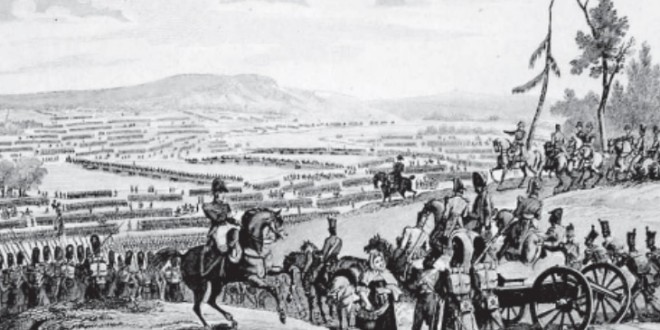by Henry L. Gaidis
![]()
TWO HUNDRED YEARS AGO, Napoleon embarked on his epic 1812 Russia Campaign with high hopes of securing his total control of the European Continent. Although the story of this tragic campaign is known by virtually every high school student, few are aware of Lithuanian involvement in that campaign. After the failed 1794 Kosciusko Insurrection, the ancient PolishLithuanian Commonwealth ceased to exist when its lands and population were divided between Russia, Prussia and Austria. Although the dual nation’s soldiers fought valiantly, they were overwhelmed by superior numbers and betterequipped forces. Many of the officers that refused to accept defeat made their way to France.
With Napoleon’s rise to power, he quickly realized the benefit these trained professional soldiers offered to his dream of expanding the French Empire, and the PolishLithuanian patriots thought he might be the tool they needed to liberate their nation. As a result, when Napoleon began recruiting these officers, they in turn encouraged more of their countrymen to join his cause. These Poles and Lithuanians fought for Napoleon with great distinction during his Italy, Spain, Germany, Poland and Russia Campaigns. During his rise to power, Napoleon defeated the Italians, Prussians and Russians and drove the British from the European Continent. Following the 1807 Campaign in Poland, Napoleon established the Duchy of Warsaw, which included part of the Lithuanian Suvalkai (Polish Suwaùki) region, leading many of his followers to believe he would eventually reestablish the PolishLithuanian Commonwealth.
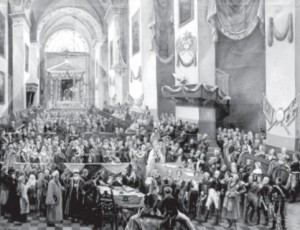
As part of the Treaty of Tilsit, the Russians agreed to support France in its war against the British, which included a blockade of England. Although the Russians paid lip service to the French cause, they continued to openly trade with Britain. By 1812, Napoleon felt he had no choice but to go to war with Russia once more. During the spring and early summer of 1812, he gradually moved his 600,000 man Grand Army across Europe into Germany and Poland. Although commonly referred to as a French army, Napoleon’s Grand Army included volunteers and inductees from over twenty different nations, including some 40,000 Poles and Lithuanians under the command of Prince Josef Poniatowski.
Napoleon’s strategy for the Russia campaign was to secretly gather his forces along the banks of the Nemunas River and then advance in three parallel columns into the heart of Lithuania. The main force under his personal command, which contained the greatest number of native-born Frenchmen, was to march directly to Vilnius, with covering columns marching north up the Baltic Coast toward Saint Petersburg and south into the Western Ukraine to repel flanking attacks. After capturing Vilnius, Napoleon would reunite his forces and surround and defeat the Russian Army in the vicinity of Gardinas (Grodno-Slonim). After such a defeat, Czar Alexander would have no choice, but to submit to his demands, eliminating the need for a winter campaign. Unfortunately, Napoleon’s plan contained two serious flaws—time and space would prove too great for his otherwise brilliantly conceived strategy.
The Russia Campaign commenced on June 23, 1812, when Napoleon ordered the Grand Army to cross the Nemunas River and invade the Russian Empire. He quickly occupied Kaunas and liberated Vilnius without any major resistance. Czar Alexander, who had been in Vilnius for the summer, immediately fled to Moscow, leaving the totally surprised Russians under the command of Field Marshal Michael Barclay de Tolly. The unprepared Russians had no choice but to retreat, leaving their Cossack cavalry units to cover their flight with scorched-earth tactics that left not only the French Army, but the Lithuanian population in the throes of hunger.
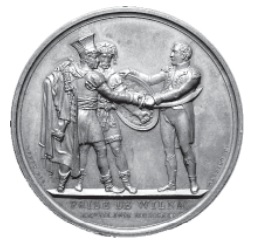
commemorate the taking of Vilnius. It
shows Napoleon handing a shield to
a Lithuanian and a sword to a Pole.
Napoleon entered Vilnius on the morning of June 27, 1812, greeted by the Lithuanians as a liberating hero with great pomp and ceremony. After securing defensive positions north and east of the city, he concentrated on establishing a government for Lithuania. On July 1, 1812, Napoleon decreed the establishment of the Provisional Government for the Grand Duchy of Lithuania and appointed senior Lithuanian nobles to high-ranking positions. Although in principle an autonomous duchy, Napoleon further set up shadow civil and military institutions under French command, which in reality became his government for the country.
Among Napoleon’s other decrees was the formation of an elite Lithuanian Lancer Regiment and its accompanying Lithuanian Tartar Scout Company, units he attached to his own Imperial Guard. He also ordered four Lithuanian cavalry and five infantry regiments, formed at Lithuania’s expense, to be assigned to his advancing army. As a result, an additional 20,000 Lithuanians were recruited into the French Army and took part in Napoleon’s 1812 Campaign.
After spending eighteen days in Vilnius, Napoleon rejoined his Grand Army in the field, which was vainly trying to engage the retreating Russian forces, and pushed it deeper into Russia. Although Napoleon had been wellreceived by all the social strata of Lithuania, their feelings quickly changed when the French army looted and pillaged the countryside as it advanced into Russia. Upon reaching Smolensk without engaging the Russians, Napoleon decided, against the advice of his staff, to pursue the Russian Army in its retreat towards Moscow. As the Russian Army neared Moscow, it was placed under the command of Field Marshal Michael Kutuzov, who decided the time was right to fight the French. The resulting Battle of Borodino, fought from September 5 through 7, 1812, was the bloodiest engagement of the campaign and cost the lives of over 30,000 Frenchmen and 43,000 Russians. Although considered a draw by most historians, the Russian Army was again forced to retreat.
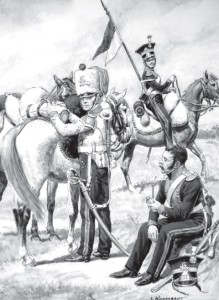
Napoleon entered Moscow on September 4, 1812 to find the city heavily burned and deserted. He continued to occupy the city for the next five weeks, expecting Czar Alexander to make a peace overture to regain his capital. However, due to a lack of supplies and the approach of winter, Napoleon was forced to withdraw to winter quarters in Lithuania, hoping to renew the campaign the following spring. Napoleon led the Grand Army out of Moscow on October 19, 1812, and after a minor engagement south of the city, was forced to retreat along the same devastated route it had taken into Russia. General Kutuzov, realizing the dire situation of the French Army, began maneuvering forces from all over Russia towards the Berezina River, where he might cut off Napoleon’s flight. During the month of November 1812, the French Army marched through snow and freezing temperatures without adequate food or clothing, with its soldiers often falling prey to the Cossacks harrying the flanks of the retreating column. Discipline began to break down, and the Grand Army slowly disintegrated. Of the estimated 130,000 men that followed Napoleon into Moscow, only about 50,000 were still with him when he crossed the Berezina River. Included among Napoleon’s retreating forces were hundreds of Lithuanians and Poles. Thousands more still in training, who waited along his line of retreat, would share the same tragic fate.
The elite Lithuanian Lancers of the Guard Regiment, riding to join Napoleon in Moscow, was surprised by a Russian Cossack Brigade and virtually decimated after fighting valiantly against a superior force. Other Lithuanian units assigned to General Dombrowski’s Division, defending Napoleon’s line of retreat, were overrun trying to hold key bridges. Upon reaching the Berezina River, Napoleon was confronted with Russian forces at his heels and a large Russian force occupying the opposite bank. As General Dombrowski’s surviving forces defended the rear, French engineers labored to build a bridge under the eyes of the Russians waiting on the other side of the river. Only an elaborate and exaggerated French troop movement caused the Russians to abandon their position, believing this bridge was a ruse and that the real crossing would be made several miles to the north. On the morning of November 26, 1812, Napoleon awoke expecting to fight a desperate battle with the Russians occupying the opposite bank. Upon realizing that his ruse had worked, Napoleon turned to a group of his bravest officers and asked if a force could cross the iceswollen river to occupy the other bank. Without hesitation, Count Przezdziecki, of the 18th Lithuanian Lancers, and Jean-François Jacqueminot, an aide-de-camp of Duke Reggio, immediately spurred their horses forward and plunged into the river. Despite the sharp cakes of ice that tore the flanks and chests of their horses, they succeeded in reaching the opposite bank and were quickly followed by French cavalry units, which then secured defensive positions. With the opposite bank protected and the bridge complete, the French column crossed the river and continued its retreat from Russia. After crossing the Berezina, Napoleon divided his column to spare his remaining forces a retreat along the same burned-over route. His surviving Polish and Lithuanian infantry units were ordered to fall back towards Warsaw by way of Alytus and Gardinas (Olita and Grodno), and his dismounted cavalry units to retreat via Merkinė (Merecz) and the Nemunas, while the main body of the Grand Army continued its retreat towards Vilnius. On December 5, 1812, as the remnants of the Grand Army reached Smurgainys (Smorgonie), Napoleon abandoned the column and fled by sled to Vilnius and, ultimately, Paris.
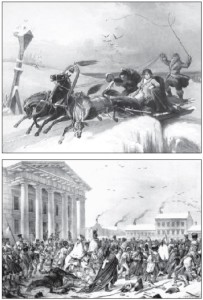
ABOVE: The Grand Army returning to Vilnius. In this nineteenth-century
lithograph, remnants of the decimated army passes the city’s Old Town Hall.
With Napoleon’s flight, the Grand Army ceased to resist the pursuing Russians and became nothing more than a merciless band of marauders, with every man acting for himself. Of the 50,000 soldiers that crossed the Berezina River and the 20,000 men that joined the column from local garrisons along the way, half perished during their four-day march to Vilnius. Only the column’s small heroic rear guard under General Ney allowed the retreating column to outdistance the pursuing Cossacks. The tragic retreat of Napoleon’s Grand Army had been kept secret from the population of Vilnius, and its arrival in the city came as a complete surprise to both the garrison forces and civilians there. As the wretched mass poured into the streets seeking food and shelter, maintenance of order became impossible. Looting and arson were commonplace, and hundreds drank themselves into a stupor on brandy and died of exposure on the freezing streets. Many more were frostbitten, and the sudden warmth of shelter led to gangrene. The unexpected sight of the army in this condition alarmed the inhabitants, and nearly everyone barricaded their doors in fear. Although the city offered some temporary refuge, the French Army abandoned the city a day later with the approach of a Cossack column, fleeing through Kaunas and not reaching safety until they reached Königsberg. Marshal Kutuzov and his main column reached Vilnius on December 12, 1812 but he halted his force upon realizing the French Grand Army was totally decimated and only trying to flee the country. He halted, not out of mercy, but because his Russian forces had also suffered heavily during the pursuit and were not fit for further combat.
Although Napoleon had been defeated, the surviving Lithuanian soldiers continued to fight for the emperor in the hope that he would still lead them to victory.
The Lithuanian infantry regiments that made their way to Warsaw were assigned to the Modlin Fortress, located on the Vistula River, where they continued to fight with great distinction against the Russians during Napoleon’s 1813 German Campaign. Though the Russians quickly captured and occupied Warsaw on February 9, 1813, the Modlin Fortress withstood a prolonged siege for another eleven months and was the last organized military formation to fight in this campaign in Poland. The brave soldiers of this garrison did not surrender until their mission to cover the withdrawal of the French and Polish Armies had been achieved and a lack of supplies and ammunition made continued struggle futile.
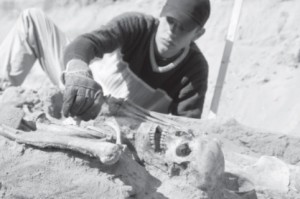
The Lithuanian cavalry regiments that had retreated to Königsberg likewise continued to fight against the Russians and Prussians in East Prussia and Denmark during the 1813 German Campaign. Remaining true to their oath of loyalty to Emperor Napoleon, these Lithuanian soldiers continued to fight and distinguished themselves during the final defense of Paris. The 1st Polish Lancers of the Guard Regiment, now composed of elements of the 3rd Lithuanian Lancers of the Guard, the Lithuanian Tartar Squadron, and 17th Lithuanian Lancer Regiment, under the command of Lithuanian General Liudvikas Mykolas Pacas, made the last great cavalry charge in the defense of Paris. Even after Napoleon’s April 20, 1814 abdication, some Lithuanians are known to have continued to serve in the Elba Honor Squadron that accompanied him into exile. These brave soldiers again followed the Emperor during his One Hundred Day Campaign of 1815 and took part in the last charge of the Imperial Guard at Waterloo. It was not until the second fall of Paris and Napoleon’s final exile to Saint Helena that the Lithuanians ended their eighteen-year love affair with the failed Emperor. Even then, the telling and retelling of the heroic deeds of these Lithuanian Napoleonic soldiers continued to inspire future generations of insurrectionists until freedom for Lithuania was finally won.
 DRAUGAS NEWS Lithuanian World Wide News in English
DRAUGAS NEWS Lithuanian World Wide News in English
